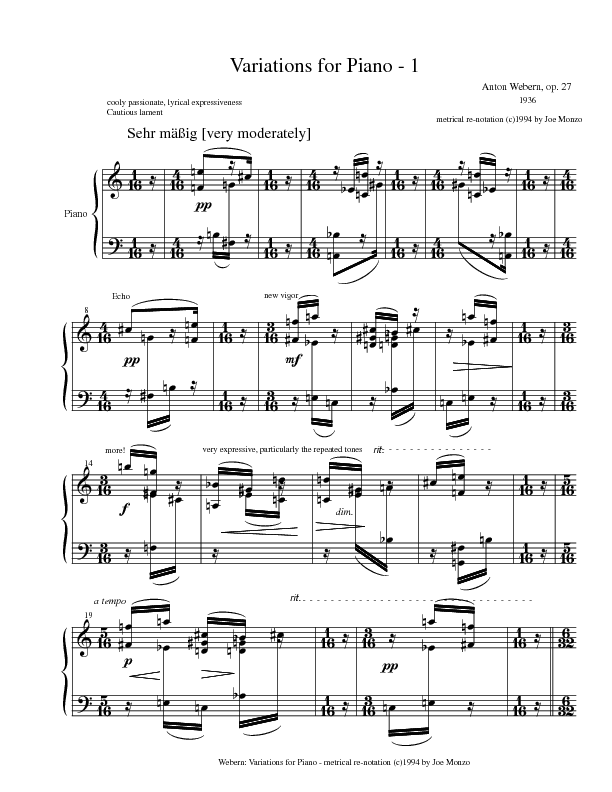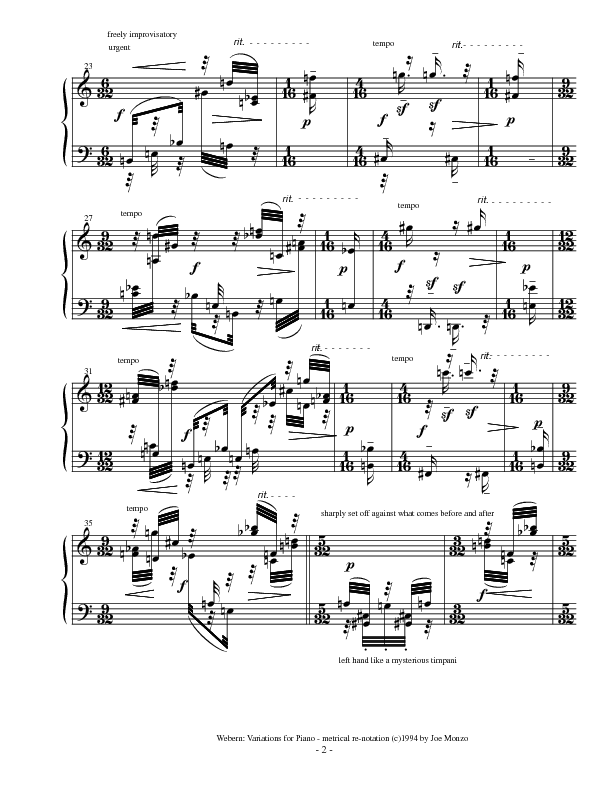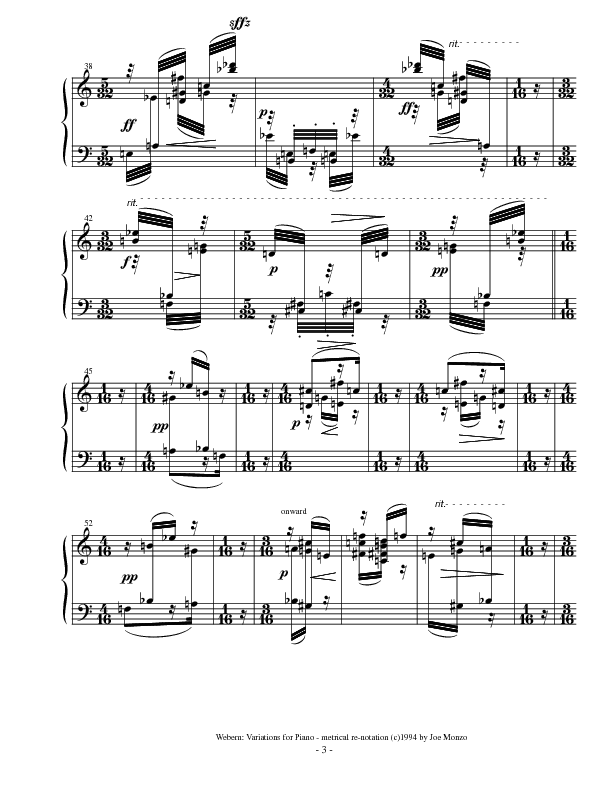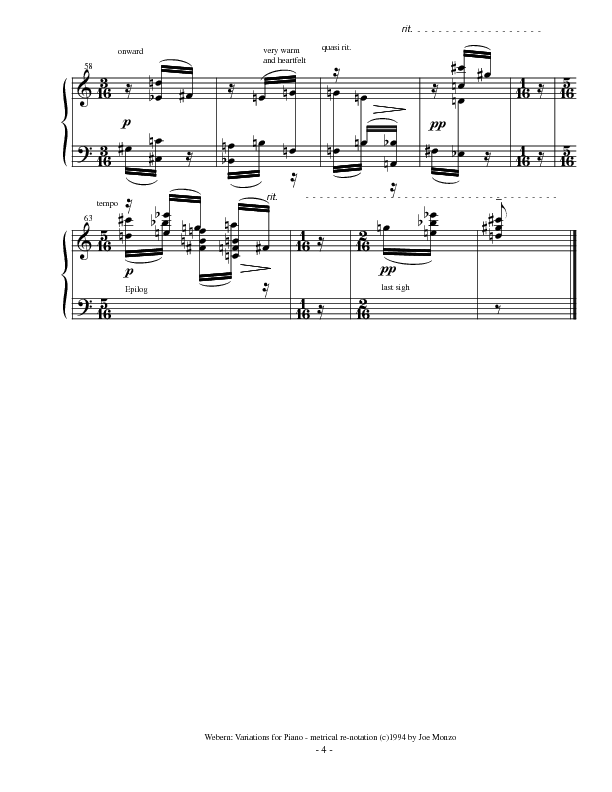Webern's Variations for Piano, 1st movement
A Metrical Analysis and Re-notation
(my mp3 of this piece, in John deLaubenfels's double-stretched adaptive 7-limit JI retuning)
One day in New York, I bought a score to Webern's Variations for Piano, op. 27, in a special new edition which had just been published. It was unusual in that it contained the annotations made by Webern while he coached Peter Stadlen in preparation for the work's premier in 1936. On the left-hand pages were a photographed facsimile of the original score with Webern's handwritten comments, and on the right side, superimposed over the regular published score, were printed both Webern's comments and printed annotations by Stadlen based on what he remembered of Webern's verbal remarks during the training. The score itself was prefaced by Stadlen's commentary on the whole proceedings (which was a reprint or excerpt from an article 1).
I found the story told by Stadlen fascinating, more of which will be revealed as this narrative progresses. Suffice to say for now that one sentence stood out in my mind when I looked at the score: Stadlen's statement that Webern imagined the piece with an enormous amount of constant rubato (an Italian term meaning great flexibility of tempo). This made a lot of sense to me, as I could see it stemming from Webern's admiration of Mahler's interpretive technique.
The key to my finding what I think is a correct interpretation of Mahler's music was the realization (from having read so many reminiscenses of Mahler's conducting and playing by those present) that Mahler felt an incredible freedom of tempo in his music-making, which allowed the music to have a subtlety of dramatic expression on a par with stage plays.
[For a chronology detailing the interactions of Mahler, Schoenberg, and Webern, as well as Zemlinsky and others, see A Century of New Music in Vienna.]
So upon examining Webern's score, I was first struck by the fact that the 1st movement was notated entirely in 3/16 meter, but the articulation of the movement's structure into the quite clearly-defined musical phrases I could perceive did not match this metrical pattern and were quite obscured by being forced into it.
I immediately set about re-notating the movement in a way which made clear the phrase structure and the movement's overall form, as well as the true meters by which the piece's rhythms were propelled.
Here is my renotation of the first movement of Webern's Variations for Piano, op. 27:
page 1

page 2

page 3

page 4

I looked into some other Webern scores dating from around the same time as Op. 27, and noticed the same incongruity in some of these. Having been a keen enthusiast of Webern since my college days, I was somewhat surprised that I had never read anything about this unusual metrical situation. I ransacked everything the local libraries had concerning Webern, and was rewarded with another surprise because, indeed, this strange metrical straight-jacketing had been noticed by others, specifically in connection with this very piece! [references still to be added at a future date]
Once I had redone the visual look of the piece, I wanted to create a MIDI sequence making my interpretation audible.
Music is inevitably tied, at least partially, to periodicity, in both harmony and rhythm, for various reasons. Part of this is simply music's often-used role in dance, part of it is our adaptation to natural cycles and rhythms of life, from the rising and setting of the sun to the sounds of modern machinery, both its hum (as in pieces by La Monte Young, whose reference frequency is the 60 Hz at which American electrical current flows) and its noisy but harmonious timbres and repetitive rhythms (as in pieces by Bill Wesley and in much of the "jungle" music featured in the recent film Modulations.
Paradoxically, two things which set European concert music (and its descendants) apart from the music of all other world cultures are, on the one hand, its manifestation of some of the most complex manipulation of periodicity in the development of harmony, and on the other hand, its large-scale renouncing of an emphasis on periodicity thru both its complex and flexible dramatic forms and phrase-structures and its virtually total acceptance of the 12-tone equal-tempered scale (the notes of which imply to greater or lesser degrees some very important rational intervals, but do not actually give any of those periodic ratios).
Beginning with the first operas (around 1600), and then really coming into its own with Beethoven's music (early 1800s), European music developed the ability to evoke the moods, emotions, and intellectual journeys traversed by one's experience while following a drama. Wagner re-applied this technique to opera (mid-to-late 1800s), and Mahler, at first following quite closely in Wagner's footsteps, re-applied Wagner's advances in compositional expressivity to the symphony.
But Mahler was also renowned as a conductor and opera director. The fact of his deep involvement in every aspect of opera production, coupled with the memoirs noted above, led me to believe that an accurate MIDI sequence of Mahler's music would incorporate not only the numerous tempo changes already stipulated in his scores, but even more numerous others which were not notated. [listen to my MIDI sequences of excerpts from Mahler's 7th Symphony and Das Lied von der Erde]
Webern, as did his teacher Schoenberg, idolized Mahler. After reading what Stadlen had said, it seemed perfectly natural to me that Webern would have written ritardandos and A Tempos all over the piece, at the junction of practically every pair of phrases. Indeed, I used these tempo markings as a guide in my re-notation of the piece. What was surprising to me was that none of the recordings and performances I had ever heard of Op. 27 seemed to take this rubato into account, at least not to the degree that I felt would be correct.
(You can download my MIDI sequence of it here.)
There is still more that could be done to enhance the expressivity of this sequence.
In the copy in which Webern pencilled performance notes to Stadlen, Webern actually wrote crescendi and diminuendi for single notes played on the piano. This indicates his desire for an expressivity that was beyond the capabilities of the instrument he chose for the job.
These dynamics could be added in a MIDI sequence, and indeed, perhaps the timbre of the instrument should be given some sustain to make a real crescendo possible. As the piano has an envelope with no sustain, a true crescendo on a single note is impossible.
Of course, I'd love to re-tune the pitches in the piece, but it would be pretty tough both to figure out which tuning to use and to justify it harmonically, since this is a serial piece and (as far as I know) Webern gave no clear clues as to what tonal implications he may have been writing into his music, as both Schoenberg and Berg did do on occasion.
(John deLaubenfels kindly retuned my MIDI-file of this piece into a variety of adaptive JI tunings. My favorite is the version in this adaptive 7-limit JI with double-stretch applied.)
It has been generally felt by many people that Webern's output embodies the cold and unemotive structuralist aspect of mid-20th-century compositional technique, and specifically, serialist technique. One of my goals with this sequence (and its future tweaking) is to reverse this thinking, and show that Webern indeed wrote very expressive music, and that this is an aspect that just hasn't been brought out much in performance before.
The question still remains as to why Webern chose to notate the pieces he wrote around this time, as he began to explore more intricate and asymmetrical meters, in strict timing. In his last few pieces (the Cantatas), he did begin to use changing meters. Perhaps, during the transitional period of Op. 27, he felt that he needed to keep the outward appearance of the piece tied to some semblance of periodicity. I would argue that the appearance of these scores led to a style of performance which emphasized a robotic periodicity of meter that ran counter to Webern's actual intentions.
For an interesting peek into Webern's early creative style, which was very expressive, listen to my MIDI sequence of my own arrangement of an early song by Webern (written originally for voice and piano), Aufblick.
REFERENCES (I still need to add dates to most of these)
| 1 |
Stadlen, Peter. 1958.
Serialism Reconsidered, The Score 22 (February), p. 12-27. |
| 2 |
Gerhard, Roberto. 1958.
Apropos Mr. Stadlen, The Score 23 (July), p. 50-57. |
| 3 |
Westergaard, Peter. 1963.
Webern and "Total Organization": an analysis of the Second Movement of Piano Variations, op. 27, Perspectives of New Music 1.2 (Spring 1963), p. 107-120. |
| 4 |
Lewin, David. _____.
A Metrical Problem in Webern's Op. 27, Journal of Music Theory 6.1 (), p. 124-138. |
| 5 |
Jones, James Rives. ____.
Some Aspects of Rhythm and Meter in Webern's Opus 27, Perspectives of New Music __ (), p. 103-. |
| 6 |
Nelson, Robert U. ____.
Webern's Path to the Serial Variation, Perspectives of New Music __ (), p. 73-93. |
| 7 |
Travis, Roy. 1966.
Directed Motion in Two Brief Piano Pieces by Schoenberg and Webern, Perspectives of New Music 4.2 (Spring-Summer 1966), p. 85-89. |
| 8 |
Fiore, Mary E. ____.
Webern's Use of Motive in the 'Piano Variations', chapter VI in The Computer and Music, p. 115-122. |
| 9 |
Fuller, Ramon. ____.
Toward a Theory of Webernian Harmony, via Analysis with a Digital Computer, chapter VII in The Computer and Music, p. 123-131. |
Updated: 2001.0803, 2010.0330
